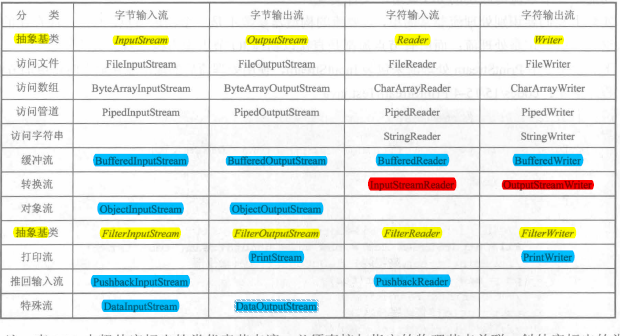Java 的10 流是实现输入/输出的基础,它可以方便地实现数据的输入/输出操作, Java 中把不同的输入/输出源(键盘、文件、网络连接等)抽象表述为"流" (stream) ,通过流的方式允许Java 程序使用相同的方式来访问不同的输入/输出源。stream 是从起源(source) 到接收(sink) 的有序数据。
流按照相对于内存的方向分为输入流和输出流,也可以按照读写的单位分为字节流和字符流,而且还可以根据流的使用不同分为节点流和封装流(采用了典型的装饰器的设计模式,使得IO流用起来非常灵活)。
以下来自core java:
In the Java API, an object from which we can read a sequence of bytes is called an input stream.

Because byte-oriented streams are inconvenient for processing information stored in Unicode (recall that Unicode uses multiple bytes per character), there is a separate hierarchy of classes for processing Unicode characters that inherit from the abstract Reader and Writer
以下是字节流和字符流的层次图。
由上图可看出,java IO 体系中有访问文件,数组,管道和字符串的节点流;以及缓冲流,对象流,推回输入流,特殊流
等高层处理流;还有两个转换流。
下面程序分别使用了字节和字符读取文件并复制一份,并且与buffered版本进行了对比。
package stream;
import java.io.BufferedInputStream;
import java.io.BufferedOutputStream;
import java.io.BufferedReader;
import java.io.BufferedWriter;
import java.io.FileInputStream;
import java.io.FileOutputStream;
import java.io.FileReader;
import java.io.FileWriter;
import java.io.IOException;
import java.io.Writer;
public class Streamtest {
/**
* @param args
* @throws IOException
*/
public static void main(String[] args) throws IOException {
FileInputStream fileInputStream = null;
FileOutputStream fileOutputStream = null;
FileReader fReader = null;
FileWriter fWriter = null;
BufferedInputStream bis = null;
BufferedOutputStream bos = null;
BufferedReader br=null;
BufferedWriter bw=null;
//stream
long byteStart =System.currentTimeMillis();
try {
fileInputStream = new FileInputStream("三国演义.txt");
fileOutputStream = new FileOutputStream("三国演义副本一.txt");
int hasRead = 0;
byte[] buf = new byte[10];
while ((hasRead = fileInputStream.read(buf)) > 0) {
fileOutputStream.write(buf, 0, hasRead);
}
} catch (IOException e) {
e.printStackTrace();
} finally {
if (fileInputStream != null)
fileInputStream.close();
if (fileOutputStream != null)
fileOutputStream.close();
long byteEnd=System.currentTimeMillis();
System.out.println("字节复制完毕!花费"+(byteEnd-byteStart)+" ms.");
}
//buffered stream
long bufferedByteStart =System.currentTimeMillis();
try {
fileInputStream = new FileInputStream("三国演义.txt");
fileOutputStream = new FileOutputStream("buffered三国演义副本一.txt");
bis=new BufferedInputStream(fileInputStream);
bos=new BufferedOutputStream(fileOutputStream);
int hasRead = 0;
byte[] buf = new byte[10];
while ((hasRead = bis.read(buf)) > 0) {
bos.write(buf, 0, hasRead);
}
} catch (IOException e) {
e.printStackTrace();
} finally {
if (bis != null)
bis.close();
if (bos != null)
bos.close();
long bufferedByteEnd=System.currentTimeMillis();
System.out.println("buffered字节复制完毕!花费"+(bufferedByteEnd-bufferedByteStart)+" ms.");
}
//reader writer
long charStart=System.currentTimeMillis();
try {
fReader = new FileReader("三国演义.txt");
fWriter = new FileWriter("三国演义副本二.txt");
char[] cbuf = new char[10];
int hasRead = 0;
while ((hasRead = fReader.read(cbuf)) > 0) {
fWriter.write(cbuf, 0, hasRead);
}
} catch (IOException e) {
// TODO: handle exception
} finally {
if (fReader != null)
fReader.close();
if (fWriter != null)
fWriter.close();
long charEnd=System.currentTimeMillis();
System.out.println("字符复制完毕! 花费"+(charEnd-charStart)+" ms.");
}
//buffered reader writer
long bufferedCharStart=System.currentTimeMillis();
try {
fReader = new FileReader("三国演义.txt");
fWriter = new FileWriter("buffered三国演义副本二.txt");
br=new BufferedReader(fReader);
bw=new BufferedWriter(fWriter);
char[] cbuf = new char[10];
int hasRead = 0;
while ((hasRead = br.read(cbuf)) > 0) {
bw.write(cbuf, 0, hasRead);
}
} catch (IOException e) {
// TODO: handle exception
} finally {
if (br != null)
br.close();
if (bw != null)
bw.close();
long bufferedCharEnd=System.currentTimeMillis();
System.out.println("buffered字符复制完毕!花费"+(bufferedCharEnd-bufferedCharStart)+" ms.");
}
}
}
结果可以看出,buffered封装后却是提高了效率。
字节复制完毕!花费1020 ms. buffered字节复制完毕!花费21 ms. 字符复制完毕! 花费90 ms. buffered字符复制完毕!花费30 ms.
关于buffer:首先要知道什么是缓冲,buffering,如CPU和硬盘之间的关系,寄存器或内存就是作为缓冲,如果没有缓冲,当CPU要向硬盘存取数据时,只能直接存取,导致效率低下。
比如总共要读取10个字符,每次用一个,那只能每次从硬盘读一个用一个,如果有缓冲,就能先直接缓冲10个,然后再从缓冲中读一个用一个,出于硬件条件等的天生受限,使用buffering会大大提高效率。
PrintStream 和 PrintWriter
PrintStream
是OutputStream的子类,PrintWriter是Writer的子类,两者处于对等的位置上,所以它们的API是非常相似的。
PrintWriter实现了PritnStream的所有print方法。对于PrintStream,所有println方法都在内部调用相应的
print方法,比如println(char
x)的方法体就是调用print(x);再写入一个平台相关的换行符。PrintStream构建时会在内部new一个BufferedWriter,所
有print方法都在内部调用这个Writer的write方法(write(String)或write(char[]))——对于
print(char[]),直接调用write(char[]);对于其他的print方法,先用String.valueOf获得参数的字符串表示,
然后调用write(String)。
对于PrintWriter,所有println方法也都在内部调用print方法,print方法调用write方法。传入OutputStream
时,PrintWriter会在内部构造一个BufferedWriter;而传入Writer时,PrintStream内部直接使用该Writer,
此时PrintWriter是否进行了缓冲全看该Writer。
所以,对于使用print系列方法的场合,二者没什么区别。
但是,PrintStream是字节流,它有处理raw
byte的方法,write(int)和write(byte[],int,int);PrintWriter是字符流,它没有处理raw
byte的方法。PrintStream和PrintWriter的auto
flushing机制有点不同,前者在输出byte数组、调用println方法、输出换行符或者byte值10(即\n)时自动调用flush方法,后
者仅在调用println方法时发生auto flushing。


